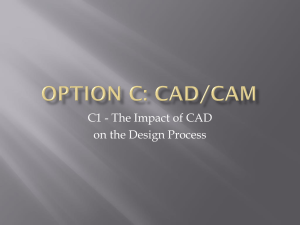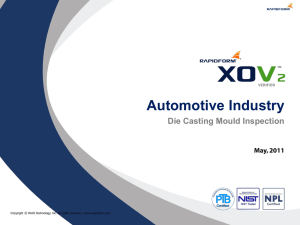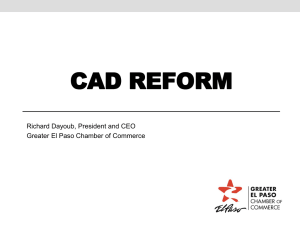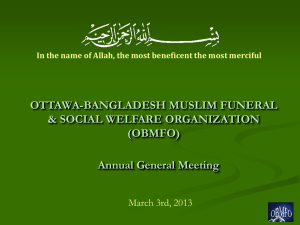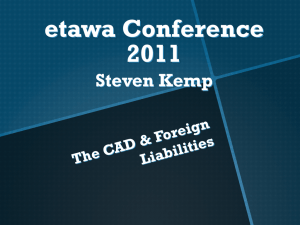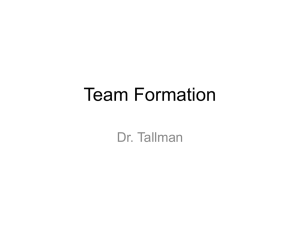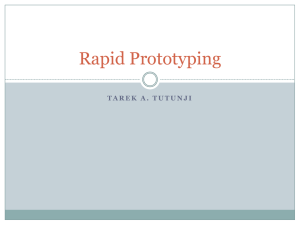Best Practices for Working with CAD and Product
advertisement
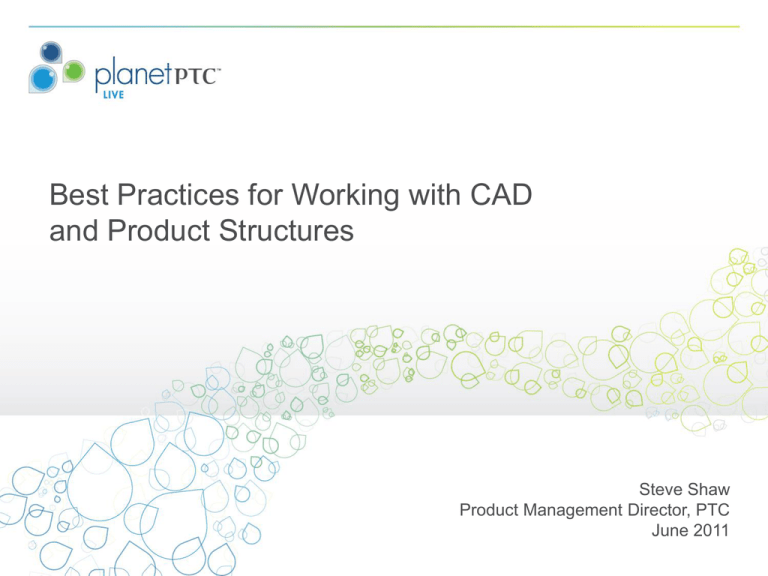
Best Practices for Working with CAD and Product Structures Steve Shaw Product Management Director, PTC June 2011 Agenda Best Practices for Working with CAD and Product Structures Background PTC Best Practices Overview PTC Best Practices Details & Supporting Capabilities Q&A 2 Background CAD-Driven Product Structure Requirements Data Sheet CAD Model Builds Assembly Part Part: Part No: Cost: Weight: Cell Phone CEL9412 $34.95 3.5 oz. Test Plan Software Code Analysis Requirements Viewable Part No: Name: Cost: Weight: Manuf: KEY124 Keypad $0.65 0.25 oz. Key, Inc. Part No: Name: Cost: Weight: Manuf.: SCR243 Screen $1.04 0.35 oz. Screen, Inc. CAD Model Data Sheet Builds Component Part Analysis Viewable Skeleton Model Not Built Software Code Test Plan CAD Model Requirements Data Sheet Builds Component Part Analysis Viewable Software Code CAD Structure Test Plan Enterprise Structure 3 Storyboard Overview 2 START 1 Business Administration 1 Preparation Leveraging New Windchill 10.0 capabilities to the fullest 2 3 4 Enterprise Top Down Design Defining a New Product Concept Using enterprise top down design 3 Detailed Design Execution Detailed Design Finalizing Product Structure 5Available for downstream activities/systems END Reconcile CAD-to-Part Relationships 4 5 Downstream deliver/usage 4 Preparation System Administration, Configuration and Process considerations START 1 Preparation Leveraging New Windchill 10.0 capabilities to the fullest 2 3 4 Defining a New Product Concept Using enterprise top down design Detailed Design Execution Finalizing Product Structure Maintaining data consistency is a must What CAD tools does the system need to manage & do they have differing needs? What information should be extracted from the CAD models? – relevant to Search? – does it contain information relevant to the Part Do different design/product/organizational disciplines have differing needs? 5Available for downstream activities/systems END 5 1 Preparation Attribute Management Identify File-based or Non-file-based attributes required for CAD – Designated Dimensions / Parameters coming from CAD authoring tools (file-based) – Attributes strictly managed in Windchill – Identify and define any constraints What CAD attributes should be propagated to its related Part? – Building Part structure from CAD propagates attributes to the Part – All, Some, maybe None 6 1 Expanded CAD Document Soft-type support with 10.0 Possible use cases may be one of the following Desiring certain behavior based on a given authoring tool. Wanting more granular control of attributes that might be applicable for specific model types or disciplines – Previous Windchill Releases have all attribute go on a single type. – For example: If I’m modeling a bearing, there may be attributes that are not applicable Managing differing OIRs (conventions and life cycles) for different disciplines. 7 1 Support for multiple CAD document soft types Select while Creating New CAD Document in Workspace New Create New CAD Document while creating New Part Drive type created based on CAD model attribute (parameter) value – Use designated parameter UPLOAD_SOFT_TYPE – Drives creation on upload of content to server Select CAD Document Type Map CAD Document soft type to Part soft types – As part of CAD document soft type definition Forward looking information subject to change without notice © 2010 PTC 8 1 Support for multiple CAD document soft types Define types based on authoring tools – Ex. Different soft types for Creo and AutoCAD – Site wide configuration using EPMDefaultSoftTypes.xml Forward looking information subject to change without notice © 2010 PTC 9 1 CAD Document Templates CAD Documents Template Support Create and check in CAD start parts into Windchill Steps to create CAD Document Template – Navigate to the “Templates” page • Available from Site Level to Context – View “CAD Document Templates” – Select new CAD Document template – Navigate to the Cad Object to be used as a template – Identify the necessary information • Including Soft Type – Select OK You can create as many templates off the same type object as necessary 10 1 Attributes to Control Associations & Part Behavior On/Off association with Boolean New Gathering Part concept Using an attribute to control whether an association between a CAD document and a part should be created Improves handling of CAD assemblies that exist only for modeling purposes Resolves the problem when the “assembly” doesn’t belong in the eBoM but it’s children do Details Details – New Part attribute Gathering (Yes/No) – Set manually on Part common attributes – Drive setting based on CAD document attribute, with new Windchill 10.0 Sitewide preference Phantom Assembly Override Attribute Name – New Windchill 10.0 Site-wide preference Part Structure Override Attribute Name • Located under Operation > Auto Associate – Exclude auto association/creation with Boolean attribute on CAD Document – Define attribute per CAD authoring tool • Located under Operations > Auto Associate • Defines attribute to be used per authoring tool © 2010 PTC 12 Defining a New Product Concept Using Enterprise Top Down Design Capabilities START Iterative process of developing complex products in a concurrent fashion by going from concept product architecture to a defined set of design deliverables 1 Preparation Leveraging New Windchill 10.0 capabilities to the Concept Product fullest Detailed Product Definition Develop Top-Down Top Level Architecture 2 3 4 Defining a New Product Concept Using enterprise top down design Detailed Design Execution Finalizing Product Structure 5Available for downstream activities/systems A.asm A Top Level Top Level A A A Create B a C b B C CAD A.asm A-Skel b a.prt b.asm 1 B c 1.prt c d C C D D d D.asm 001 D-Skel.prt E 001.prt 002 END 1.prt B b.asm c a.prt b a B c A-Skel a Top Level E.asm 002.prt 003 003.prt 13 2 Enterprise Top Down Design Challenge: Design complex multi-disciplined products Practice: Develop hi-level product architecture that drives a defined set of MCAD design deliverables used in concurrent and iterative development of complex products Create initial enterprise product architecture Capabilities: Create corresponding CAD deliverables Simultaneous creation of enterprise part & associated CAD structures Interactive preview for conceptual development of design structures and validation Preview and manipulate in lightweight environment Concurrent editing of associated structures with pro-active reconciliation of differences Drive CAD deliverables Synchronize and drive controlled changes throughout concurrent design development Benefits: Manage changes and relationships Engineer products from top-down Shorten time to design by enabling concurrent design process Eliminate manual rework with automated communication of changes © 2010 PTC 14 2 View the video here 15 2 Enterprise Top Down Design Capabilities & Workflow Simultaneous Creation of Part & Associated CAD Document from Create Part UI – Folder browser – Product Structure Browser Edit Edit part structures in PSB and PSE – Supports Adds & Removes – Manual position entry/editing – Set flag to indicate change to be reflected in CAD Positioning in Creo View and Save to PSB – Components positioned in CAD when loaded Compare & Build Update CAD Assembly from Part Structures – Compare and build in Structure Compare UI – Option to execute “reverse build on check-in CAD Tools supported – Creo 1.0 and Creo Elements/Pro 5 – CATIA V5 Validate Forward looking information subject to change without notice © 2010 PTC 16 Detailed Design Execution “Bottom Up” design completion and product structure updates START – Creo 1.0 ability to accept/reject TDD changes 1 Preparation Leveraging New Windchill 10.0 capabilities to the fullest 2 3 4 Retrieval of TDD created assembly Defining a New Product Concept Using enterprise top down design Detailed Design Execution Finalizing Product Structure 5Available for downstream activities/systems Complete detailed design – – – – Working in CAD tool Data reuse New models/geometry constraints Design complete – Associate/auto-associate new models to Parts – Flag item as gathering – Use parameters to control part creation behavior Check-in – Product structure updated END 17 3 Detailed Design design of new components define parametric relationship Designate Parameter & Attributes design collaboration Edit/Create CAD-toPart Associations apply constraints 18 3 Design In Context Overview Enable Designers to create or update designs faster by finding the right information Filter CAD Assemblies and/or Product Structures in Windchill – Spatial criteria (Box, Sphere, Proximity) – Attribute criteria Preview Filtered Structures in Lightweight Viewer (Creo View) – Configured Digital Mockup (cDMU) – Design Reviews – Clash and Interference Mgmt Load in CAD Tool to perform Design change CAD Tools supported – Creo Elements/Pro 5.0 – Creo 1.0 – CATIA V5 Forward looking information. Subject to change without notice © 2010 PTC 19 Finalization of Product Structure Reconcile differences between CAD Assembly and Product Structure START 1 Preparation Leveraging New Windchill 10.0 capabilities to the fullest 2 3 4 Defining a New Product Concept Using enterprise top down design Detailed Design Execution Leveraging the CAD assembly to generate rich intelligent Product Structures How things are modeled doesn’t always reflect the product structure, or Engineering Bill of Material Engineers need tools (and) flexibility to make adjustments Downstream consumers and processes depend on an accurate BoM Finalizing Product Structure 5Available for downstream activities/systems END 20 4 Detailed Design CAD Driven Product Structure Challenges CAD Model BOM Parts Structure For Modeling purposes only CAD DMU CAD Model specific subassy level not needed in Product structure Erroneously built in structure Incorrect Quantity modeled in CAD More flexibility Management of attributes & processes limited for CAD CAD and Product Structure not always the same Product Structure changes tied to workspace & CAD users No tools to view and compare structure © 2006 PTC 21 4 Improved Part – Document Relationships Top Level A Goals – Deliver more flexibility to user working with product structure driven from CAD data – Enable user outside of CAD tools to work with CAD driven product structure Key Capabilities Top-level.asm A.asm a a.prt b b.asm 1 1.prt How can I change my Product Structure but keep the association to the CAD Model? – Provide environment for viewing CAD and Product Structure side-by-side • Compare differences • Make edits • Provide graphical feedback – Relax restrictiveness of build rules • Edit Product Structure qty. • Restructuring capabilities – Parameter driven part creation capabilities © 2008 PTC 22 4 Structure Compare Launched from the Compare Action Side-by-side comparison of structures – CAD-to-Part – Part-to-CAD – Part-to-Part Highlight and Navigate differences Additional cross-highlighting reporting in lower third Lightweight editing Bottom Up and Top Down Design build support © 2008 PTC 23 4 Structure Compare Central Column for difference reporting Build Structure on RHS Difference Navigation Configure table display Add’l reporting and comparison on highlighted row Search structure © 2008 PTC 24 4 Editing CAD Driven Product Structure Gathering Parts Toggle gathering part on/off Purpose – Handing assemblies that are for modeling only – Elevating its children in the BoM Product Structure – Identified with special part icon – Controlled by Part attribute • Edit Common Attributes toggle on/off – Ability to initially set using CAD attribute BoM reports – Excluded from BoM reports – Children of gathering part maintained – Children elevated up a level in BoM Toggle gathering part on/off Sub-asm_1 excluded children comp_3.prt & comp_4.rt elevated to 1st level © 2008 PTC 25 4 Editing CAD Driven Product Structure What’s modeled isn’t always exactly what you want Changing Quantities – Including for CAD built occurences Adding non-modeled items – Bulk items © 2008 PTC 26 4 Editing CAD Driven Product Structure What’s modeled isn’t always exactly what you want Deleting unwanted (built) members – Model included in assembly for reference (not part of BoM) – Correcting any unwanted items in structure Decide whether change should be propagated back to CAD System automatically keeps track of changes with Deleted Occurences © 2008 PTC 27 4 View the video here 28 Release to production systems START 1 Preparation Leveraging New Windchill 10.0 capabilities to the fullest 2 3 4 Defining a New Product Concept Using enterprise top down design Detailed Design Execution Releasing BoM to downstream process – Exporting BoM reports – Available for MPM – Publishing to ERP other downstream systems Manufacturing Engineer Finalizing Product Structure 5Available for downstream activities/systems END 29 Questions? Thank you!
